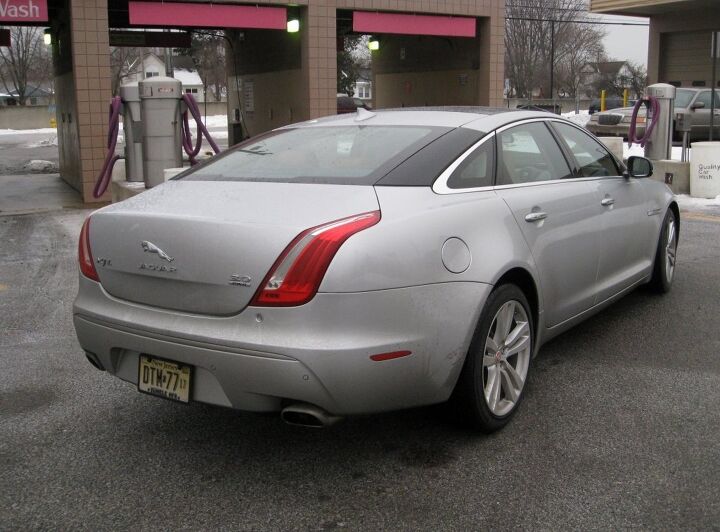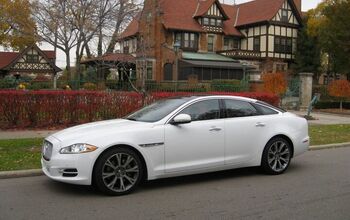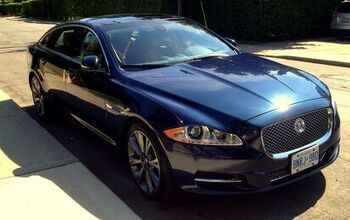2015 Jaguar XJL AWD Portfolio Review

In February of 2013, when speaking to the opening breakfast of the Chicago Auto Show, Andy Goss, the head of Jaguar Land Rover of North America, made a couple of comments about the luxury market in the United States. He said that 90 percent of vehicles with luxury nameplates are sold with V6 engines and you can’t sell a luxury car north of the Mason-Dixon line if you don’t at least offer all-wheel drive. The 2015 Jaguar XJL AWD Portfolio is the result of Goss’ perception of the lay of the luxury land.
There are those who believe true luxury starts at eight cylinders but the simple truth is most Jaguars ever made, including most of the cars that have carried the XJ nameplate, were powered by six cylinder engines, specifically the classic DOHC inline six in 3.8 and 4.2 liter versions. I’ve owned one of those XJs so the idea of driving Jaguar’s biggest, most luxurious sedan with ‘only’ a six doesn’t bother me. Besides, Jaguar’s current supercharged V6 is tuned to provide 340 horsepower. While that’s 10-15% less power than Jaguar’s naturally aspirated V8 puts out, by my standards it was quick enough. A friend and customer of mine has been driving leased Jaguar XJs for more than a decade and he told me that he didn’t like the performance of the XJ with the six. Another XJ owner, whose car does have a six, told me she loved it. Jaguar quotes a 0-60 time of 6.1 seconds. Whether that’s quick enough for you, well, that’s up to you.
The pewter colored paint looked great when clean, but got pretty dirty in winter driving.
As I said, it’s quick enough for me. Over the past few years I’ve reviewed a variety of Jaguar XF and XJ models. At the 2015 New York Auto Show, Jaguar had the formal introduction of their new XF, which is now based on Jaguar’s aluminum architecture and hundreds of pounds lighter than the XFs I’ve driven in the past. The reason for that change is the bigger XJ was actually lighter and had better performance and handling than the previous XF when equipped with the same powertrains. Jaguar’s head of design Ian Callum acknowledged that at the NY show. Though the XJ is big, and the longer wheelbase XJL even bigger, it’s relatively light and nimble, and I don’t think many people will find the lack of an eight cylinder engine to be a significant performance detriment.
When the current body style XJ was introduced, Callum’s use of black trim blending in with the rear window to visually isolate the roof panel was criticized by many. It seems as if Callum is being validated by other designers, as the new Nissan Maxima and Lexus RX, introduced earlier this month at the New York Auto Show, both feature somewhat similar black panels.
In one area, handling, the smaller and lighter six may help offset the additional weight of the components needed to drive the front wheels as well as the back. Of course, without driving them back to back I can’t say for sure, but based on memory the AWD XJL feels just as balanced and handles just as well as the V8 powered rear-wheel drive versions I’ve driven. As mentioned, the XJL feels nimble. You don’t get the feeling you’re driving one of the largest cars on the road. It’s the automotive equivalent to a gentleman or lady’s well fitted suit. While the XJ’s flanks are substantial, visibility is outstanding thanks to a third side light of glass at the C pillar.
If the 340 horsepower V6 seems up to the task of powering a full scale luxury sedan, what about all-wheel drive, Andy Goss’ other benchmark for selling luxury cars in this market? Jaguar’s all-wheel drive system is now available in all of their cars – XJ, XE and the new XF introduced earlier this month at the New York show. The AWD unit, developed with the expertise of the Land Rover side of the company, worked very well. I specifically asked Jaguar if they had an AWD car for me to test out this winter and, fortunately for this review, the Detroit area got about two inches of snow the morning the XJL was dropped off. Ideal conditions to see how the all-wheel drive performed in poor traction conditions. Well, almost ideal conditions. The test car came equipped with all-season tires.
As it turned out, though, the lack of true winter tires ended up demonstrating just how well Jaguar’s AWD works. While the XJL has aluminum construction, it’s still a big car and the AWD version tips the scale at over two tons. There’s some mass to contend with and 340 hp is more than enough to spin tires in bad traction conditions. I was deliberately being ham fisted with the car, trying to make it slide and get out of shape on turns. Because of the all-season tires’ lack of grip in the snow, it was indeed sliding, and it would start to get out of shape, but the AWD, traction control and stability control would step in and keep the car traveling in my intended direction. It wasn’t particularly subtle, and there were some odd sounds going on, but the systems did get the car under control. If you do get an AWD Jaguar, you can afford a set of proper winter tires. Throw on some Blizzaks and your Quattro equipped Audi driving neighbors won’t have anything on you.
The rest of the car was as expected from Jaguar. Space, pace and grace. The cabin was first rate; the seats very comfortable and everything within easy reach. With the L designation in the model name comes substantial rear seat room. Six footers should easily be able to sit behind people just as tall.
While it isn’t world class, the infotainment system is a huge improvement over the clunky Jaguar interface most reviewers dinged a few years ago. I’d say it was competitive with other systems if not at the head of the class. My Samsung Android phone worked seamlessly via Bluetooth. While the light brown leather interior at first looked a bit visually jarring, that was only because I’ve gotten so used to black and grey interiors. Over the week the aesthetics of the brown leather grew on me.
What is world class, I think, is the Meridian branded audio system – a truly audiophile quality set of components. Car sound systems are getting very, very good. One mark of a good sound system is resolution and transparency, allowing you to hear individual instruments instead of a blurry mess. You gain a new appreciation for what you thought were familiar recordings. With this system, you can count just how many acoustic guitars Jimmy Page multi-tracked on Over The Hills And Far Away.
I’m cynical about the business of car audio system branding. The Panasonic-made audio systems in Volkswagen cars carry the Fender brand because those three companies believe American consumers are likely to associate the name Fender more generally with music and rock ‘n’ roll than as a company noted for the distinctive distortion of its guitar pickups and amplifiers. The audio system in the XJL was so good I’d have a hard time believing the audio experts at Meridian, an elite UK audio brand, were not involved in its application.
Also first rate is the way Jaguar engineers have calibrated the 8-speed ZF automatic transmission. Upshifts are so smooth as to be almost imperceptible, and the way the transmission and ECU work together to slow the car when coasting down to a stop was very impressive. I don’t think I could use engine braking and downshifting as effectively myself with a clutch and manual gearbox.
Besides yielding more than adequate performance, one result of the 8-speed transmission and six cylinder engine is rather impressive fuel economy. The XJL is about as big a car as you’ll find on the American road and in about 600 miles of mixed driving, half urban/suburban and the other half on interstate highways, I saw 24.7 mpg. If I recall correctly, my old mid 1980s Jaguar XJ with the 4.2 liter inline six got 14 mpg.
Speaking of fuel, why do cars that require premium fuel typically call for 91 octane, whereas the vast majority of gasoline stations only offer 87, 89, and 93 octane? There’s no point in paying for more octane than you need so I typically blend 89 and 93 half and half to save money.
Rear passengers in the long wheelbase XJL get their own climate controls, with heated and cooled seats, which I’m sure will be appreciated when Shanghai gets hot and humid.
Not liking to be a cheerleader, I wish I could find things to criticize about the XJL AWD Portfolio, but everything worked flawlessly, even down to the automatically adjusting windshield wipers. While it’s cliche to say there aren’t any bad cars sold today, it’s not cliche to say there are a lot of great cars you can buy at just about every price point. I don’t have a problem saying the XJL AWD is a great car. When I’m reduced to complaining the automatic climate control seemed to be calibrated a couple of degrees off from what I’m used to, how could I say otherwise?
Jaguar Land Rover of North America provided the car, insurance and a tank of premium gasoline.
Ronnie Schreiber edits Cars In Depth, a realistic perspective on cars & car culture and the original 3D car site. If you found this post worthwhile, you can get a parallax view at Cars In Depth. If the 3D thing freaks you out, don’t worry, all the photo and video players in use at the site have mono options. Thanks for reading – RJS

Ronnie Schreiber edits Cars In Depth, the original 3D car site.
More by Ronnie Schreiber
Latest Car Reviews
Read moreLatest Product Reviews
Read moreRecent Comments
- Theflyersfan Matthew...read my mind. Those old Probe digital gauges were the best 80s digital gauges out there! (Maybe the first C4 Corvettes would match it...and then the strange Subaru XT ones - OK, the 80s had some interesting digital clusters!) I understand the "why simulate real gauges instead of installing real ones?" argument and it makes sense. On the other hand, with the total onslaught of driver's aid and information now, these screens make sense as all of that info isn't crammed into a small digital cluster between the speedo and tach. If only automakers found a way to get over the fallen over Monolith stuck on the dash design motif. Ultra low effort there guys. And I would have loved to have seen a retro-Mustang, especially Fox body, have an engine that could rev out to 8,000 rpms! You'd likely be picking out metal fragments from pretty much everywhere all weekend long.
- Analoggrotto What the hell kind of news is this?
- MaintenanceCosts Also reminiscent of the S197 cluster.I'd rather have some original new designs than retro ones, though.
- Fahrvergnugen That is SO lame. Now if they were willing to split the upmarketing price, different story.
- Oberkanone 1973 - 1979 F series instrument type display would be interesting. https://www.holley.com/products/gauges_and_gauge_accessories/gauge_sets/parts/FT73B?utm_term=&utm_campaign=Google+Shopping+-+Classic+Instruments+-+Non-Brand&utm_source=google&utm_medium=cpc&hsa_acc=7848552874&hsa_cam=17860023743&hsa_grp=140304643838&hsa_ad=612697866608&hsa_src=g&hsa_tgt=pla-1885377986567&hsa_kw=&hsa_mt=&hsa_net=adwords&hsa_ver=3&gad_source=1&gclid=CjwKCAjwrIixBhBbEiwACEqDJVB75pIQvC2MPO6ZdubtnK7CULlmdlj4TjJaDljTCSi-g-lgRZm_FBoCrjEQAvD_BwE











































Comments
Join the conversation
I feel a bit cynical about high end car audio systems, because I get the feeling that a $6,000 stereo is really buying you $200 in upgraded speaker components, $500 for a Class D amp, $300 to pay for the R&D, and $5,000 for markup. I auditioned a pair of Meridian DSP 5000's about 18 years ago. I was very impressed, but not enough to spend the $40,000 or so they wanted for those loudspeakers. Since then, I've come across many loudspeakers, usually Canadian made and a hundredth the cost, that are similarly good.
Is this a review or a press release? V6 may be fast enough. Infotainment system is competent. Meridien audio is great. 8 speed transmission manages to actually shift. AWD seems to work well even without snow tires. Is that really all there is? How does it compare to other sporting large luxury sedans (e.g., the Panamera)? Where are the criticisms? How about a bit more detail on the interior construction and quality? Does it match a German? I doubt it matches Lexus in panel fit. And by the way, those air vents are hideous.